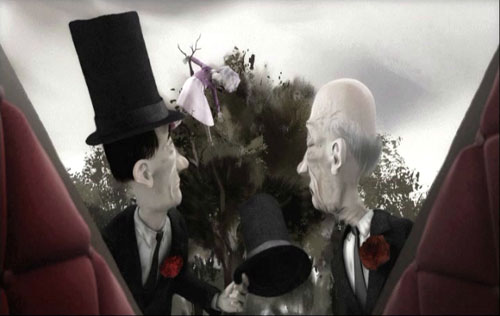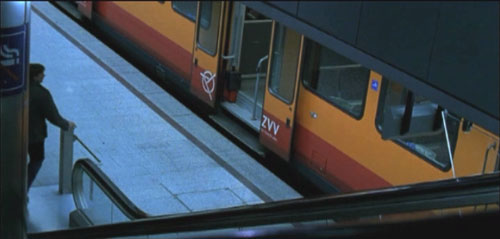This Way Up
Kristin here–
Last year I blogged about the program [2] of Oscar-nominated live-action and animated shorts that played at our local Sundance multiplex. Award season has rolled around again, and Sundance will be among 60 theaters nationwide showing this year’s films. Some venues will open them on February 6, with others showing the program during the following weeks running up to the Oscar ceremony on February 22. (Sundance here will run them for a week starting February 13.)
It used to be very difficult to see the Oscar-nominated shorts, unless they were by Pixar or Aardman. Then Shorts International, a British company distributing its films via satellite and iTunes, and Magnolia Pictures, a theatrical and home-entertainment distributor, teamed up to make these programs available. The first set went out in early 2006, displaying the nominees for the year 2005. The press release for this year’s program says that the popularity of these theatrical releases has gone up 223% in the intervening period. On February 17, the 2008 nominees will be released on iTunes.
The first three years’ worth were released as DVDs, but there’s no such plan announced in the press release for this year. Links for the first two volumes can be found in last year’s entry. The one for the 2007 films is here [3]. (Two of them, My Love and I Met the Walrus, were not included on the disc.)
Don’t take my opinions as guides for voting in your office Oscar pool. My choice for last year’s best live-action short, The Tonto Woman, didn’t win. Le Mozart de Pickpockets, which I dismissed as lightweight, did. I’m still baffled, since it’s quite a conventional little comedy. Maybe it’s because that was the only short among the five that involved a cute kid.
My favorite among the animated shorts, Même les pigeons vont au paradis, lost, but I did correctly predict that Peter and the Wolf among the 2007 animated nominees was the likely winner. Another cute kid plus Prokofiev equals Oscar bait. I voted for it in our faculty-grad student pool.
As I said last year, live-action shorts often have the feel of being portfolio projects—mainly because many of them are just that, first directorial efforts by film-school graduates trying to move from commercials to features. Perhaps as a result, they are very skillfully made but tend to stick to fairly conventional subject matter and treatment. They also go for Serious Themes, a tendency very evident in this year’s program. Of course, some people, including many Oscar voters, like Serious Themes.
Animated shorts, on the other hand, are often made by experienced pros and hence are often more daring and funny. Only one of this year’s cartoons goes for poignancy. I think most commentators assume that Presto, this year’s Pixar short, will walk away with the Oscar. Pixar always does. (At least in the shorts department. I am still annoyed that Shrek beat out Monsters, Inc.)
Here’s an overview of the program.
The Animated Shorts
 [4]Lavatory Lovestory, dir. Konstantin Bronzit, Russia, 2006, 10 minutes. Bronzit has gone for minimalism, with black and white line drawings and no dialogue. A lavatory attendent in a men’s room suddenly starts finding bouquets in her tips jar and searches for her secret admirer. The flowers are the only touches of color. It’s well animated, contains many clever, amusing bits, and without getting mawkish about it, makes the point that love can come to anyone.
[4]Lavatory Lovestory, dir. Konstantin Bronzit, Russia, 2006, 10 minutes. Bronzit has gone for minimalism, with black and white line drawings and no dialogue. A lavatory attendent in a men’s room suddenly starts finding bouquets in her tips jar and searches for her secret admirer. The flowers are the only touches of color. It’s well animated, contains many clever, amusing bits, and without getting mawkish about it, makes the point that love can come to anyone.
Octapody. Directed by Emud Mokhberi, Thierry Marchand, Julien Bocabeille, François-Xavier Chanious, Olivier Delabarre, and Quentin Marmier, France, 2007, 2:10. A computer-animated film that goes for a spare look, with relatively few complexly rendered surfaces. The stylization works well for a tale of two octopi in love, one of whom is snatched from their tank in a fish shop and sent off in a van, presumably to a 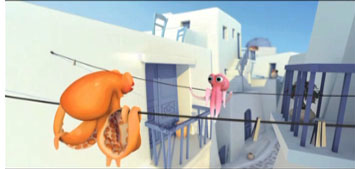 [5]restaurant. The other gamely gives chase, freeing his? her? mate. More chasing ensues. All of this goes at a break-neck pace; note the length. I was glad to be watching on DVD, so I could go back and observe details that had whisked by almost imperceptibly. The expressions of the octopi are rendered vividly, despite the lack of mouths. Again, no dialogue, though the creatures occasionally make little peeping noises. The whole thing has the look of an earlier Pixar film, though one playing fast-forward. It would almost be plausible as an alternative to Presto, but I find it difficult to imagine the Academy membership voting for a two-minute film that it took six directors to make! (Only the first two listed above were nominated.)
[5]restaurant. The other gamely gives chase, freeing his? her? mate. More chasing ensues. All of this goes at a break-neck pace; note the length. I was glad to be watching on DVD, so I could go back and observe details that had whisked by almost imperceptibly. The expressions of the octopi are rendered vividly, despite the lack of mouths. Again, no dialogue, though the creatures occasionally make little peeping noises. The whole thing has the look of an earlier Pixar film, though one playing fast-forward. It would almost be plausible as an alternative to Presto, but I find it difficult to imagine the Academy membership voting for a two-minute film that it took six directors to make! (Only the first two listed above were nominated.)
This Way Up. Directed by Smith & Foulkes, United Kingdom, 9 minutes, 2008. This was my favorite among this year’s shorts, always excepting Presto. It and Octapody are the ones I would want to have, to watch again and bring out for the entertainment of friends. It’s a macabre little tale of father and son undertakers who struggle to get the coffin of a sweet little old lady to its waiting grave. A dislodged rose petal in her house falls, setting off a Rube Goldberg-style string of events culminating in the crushing of their hearse. Setting out on foot, they encounter numerous obstacles, resulting in gruesome adventures with the corpse. These culminate when all three are catapulted into Hell.
The animation is complex and very well done. During the somber, slow first half, a color scheme of shades of gray is maintained (see above), but the lively, spectacular Hell sequence pops with garish colors and dazzling movement. I liked the subtle touches, like the indications that young Shank is bored with the family business. It’s so smart and well done that I think it’s the only entry that might have a chance of pulling off an upset.
I had never heard of Smith & Foulkes or the production company, Nexus Productions. Turns out they mainly make commercials and the occasional short. This Way Up was done for the BBC. I didn’t see Lemony Snicket’s a Series of Unfortunate Events, but Smith & Foulkes created The Little Elf, the brief, sickly sweet Disney pastiche that opens the film. You can see it and other films on the Nexus website [6]–if you can figure out the links, which seem to dodge away when you try to click on them.
La Maison en petits cubes. Directed by Kunio Kato, Japan, 12 minutes, 2008. Visually this is appealing, with 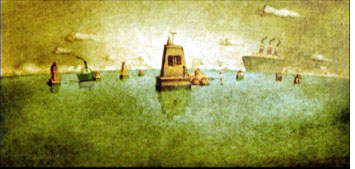 [7]what appears to be watercolor painting based on the style of Lyonel Feininger. (His paintings, not his comic strips.) The premise is that the hero, an old sailor, and his neighbors live in houses built gradually upward with added cube-like rooms as the ocean that surrounds them rises.
[7]what appears to be watercolor painting based on the style of Lyonel Feininger. (His paintings, not his comic strips.) The premise is that the hero, an old sailor, and his neighbors live in houses built gradually upward with added cube-like rooms as the ocean that surrounds them rises.
Anti-global warming, I thought, but no, turns out that the stalagmite-like houses are symbols of life, while the ocean is time. The hero scuba-diving downward and remembering his wife and daughter in successively lower rooms, as they appear younger and younger. I found it overly sentimental. Some others will presumably find it pleasantly poignant.
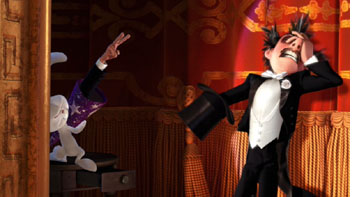 [8]Presto. Directed by Doug Sweetland, USA, 5 minutes, 2008. Do I need to say anything about this? The vast majority of you presumably saw it when it was shown in front of WALL-E. It’s also on the WALL-E DVD. Presto is a pastiche of Warner Bros. cartoons of the golden era, though not one that looks merely derivative. Set in a vaudeville theater, it deals with a wascally, hungry rabbit punishing a magician who withholds his carrot. Not a wise-cracking Bugs Bunny type though, since there’s no dialogue. It proceeds at a breakneck pace and jams an absurd number of gags into its short running time.
[8]Presto. Directed by Doug Sweetland, USA, 5 minutes, 2008. Do I need to say anything about this? The vast majority of you presumably saw it when it was shown in front of WALL-E. It’s also on the WALL-E DVD. Presto is a pastiche of Warner Bros. cartoons of the golden era, though not one that looks merely derivative. Set in a vaudeville theater, it deals with a wascally, hungry rabbit punishing a magician who withholds his carrot. Not a wise-cracking Bugs Bunny type though, since there’s no dialogue. It proceeds at a breakneck pace and jams an absurd number of gags into its short running time.
The live-action shorts
On the Line. Directed by Reto Caffi, Switzerland-Germany, 26 minutes, 2007. A psychological study of a guard in a Swiss department store who falls in love with a woman who works in the book section. At first he appears to be a creepy stalker, watching her in his office via security cameras and times his commutes home to be on the same train (see below). Possibly, though, he is just shy and awkward. On one train trip he sees a young man he takes to be his rival set upon by thugs and ducks out at a stop, leaving the man to be beaten to death. Thereafter he agonizes over his act, hiding it after he unexpectedly develops a relationship with the woman. The story manages to keep us guessing about the protagonist’s character, suggesting at times that he is simply a decent fellow who made one dreadful mistake. So often the acting in short, independent films is a weak point, but Roeland Wiesnekker and Catherine Janke are excellent as the two main characters.
New Boy. Directed by Steph Green. Ireland, 11 minutes, 2007. In New Boy, a recent immigrant from Africa immediately draws the hostility of two bullies on his first day in a new school. At first we may assume they 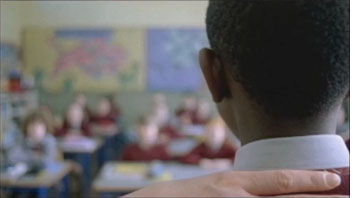 [9]act out of racism, though the ending suggests that the problem is just boyish belligerence. The main sympathy for Joseph comes from a series of brief flashbacks to him at school in his original homeland, where his father is the teacher; one day some soldiers arrive and take him away to some unknown fate. The Irish teacher’s strict behavior with a boy who has endured such traumatic events ends up being key to the surprise ending—one which I found too optimistic to be plausible but definitely narratively satisfying.
[9]act out of racism, though the ending suggests that the problem is just boyish belligerence. The main sympathy for Joseph comes from a series of brief flashbacks to him at school in his original homeland, where his father is the teacher; one day some soldiers arrive and take him away to some unknown fate. The Irish teacher’s strict behavior with a boy who has endured such traumatic events ends up being key to the surprise ending—one which I found too optimistic to be plausible but definitely narratively satisfying.
Toyland. Directed by Jochen Alexander Freydank, 14 minutes, 2007. The Academy members love Holocaust films, so this film might well take the prize. Another film about a Christian boy and a Jewish boy who become close friends, only to have the Jewish family taken from their home to a train waiting to depart. To comfort her son, the Christian mother tells her son that they’re going to “Toyland” but that he can’t go along. Naturally he slips out and tries to do so. It’s a good film, I think, though the elaborate flashback structure is perhaps a little too ambitious for such a short narrative. Still, I give it credit for not going down the path that a spectator would almost automatically assume it will. (On the screener, this film was slightly squeezed and quite dark, so I haven’t supplied an illustration.)
The Pig. Directed by Dorte Høgh, Denmark, 22 minutes, 2008. This is a little lesson in ethnic tolerance that 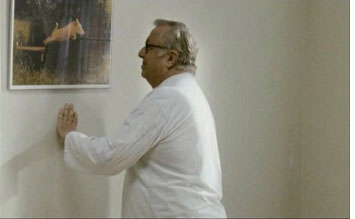 [10]sneaks up on you. An elderly man checks into a hospital for a rectal operation and is then told he has polyps that may be cancerous. In the sterile environment, he battens onto a humorous painting of a pig, treating it as a sort of friend. It mysteriously disappears, and we suspect callous treatment by the hospital until we realize that the other patient in the room is Muslim. So no, the staff were being thoughtful toward that man’s family. Tensions rise as the protagonist insists on having his pig back, and the other patient’s son resists this on religious grounds. What to do if either side being tolerant means the other side is intolerant? Another surprise ending solves the matter pleasantly, which seems to be a common ploy in short films, as in short stories. I would probably vote for this film, though I suspect it will be seen as less hard-hitting than some of the others.
[10]sneaks up on you. An elderly man checks into a hospital for a rectal operation and is then told he has polyps that may be cancerous. In the sterile environment, he battens onto a humorous painting of a pig, treating it as a sort of friend. It mysteriously disappears, and we suspect callous treatment by the hospital until we realize that the other patient in the room is Muslim. So no, the staff were being thoughtful toward that man’s family. Tensions rise as the protagonist insists on having his pig back, and the other patient’s son resists this on religious grounds. What to do if either side being tolerant means the other side is intolerant? Another surprise ending solves the matter pleasantly, which seems to be a common ploy in short films, as in short stories. I would probably vote for this film, though I suspect it will be seen as less hard-hitting than some of the others.
Manon sur le bitume. Directed by Elizabeth Marre and Olivier Pont, France, 15 minutes, 2007. A young 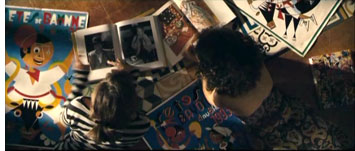 [11]woman struck by a car lies on the asphalt, surrounded by onlookers. We hear her voice, speculating on what her friends will do after her death. As we see the scenes she imagines, we wonder if these are flashforwards or imaged scenes. Is she really dying? A very polished item which manages to cut among her various friends going about their work or meeting to mourn her and allows us to keep track of who they are. Very, very French.
[11]woman struck by a car lies on the asphalt, surrounded by onlookers. We hear her voice, speculating on what her friends will do after her death. As we see the scenes she imagines, we wonder if these are flashforwards or imaged scenes. Is she really dying? A very polished item which manages to cut among her various friends going about their work or meeting to mourn her and allows us to keep track of who they are. Very, very French.
I’m old enough to have grown up watching programs that included shorts. Cartoons, travelogues, even newsreels when I was very young, in addition to trailers. It’s a pity that shorts, which have traditionally been intended to be shown in small groups before a feature, are now clustered in a way that makes them rush by one after another. Still, it’s hard to see shorts on the big screen, so this year’s program is an opportunity to be seized.
On the Line
